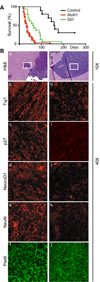Atoh1 inhibits neuronal differentiation and collaborates with Gli1 to generate medulloblastoma-initiating cells
- PMID: 20516124
- PMCID: PMC2896438
- DOI: 10.1158/0008-5472.CAN-09-3740
Atoh1 inhibits neuronal differentiation and collaborates with Gli1 to generate medulloblastoma-initiating cells
Abstract
The morphogen and mitogen Sonic Hedgehog (Shh) activates a Gli1-dependent transcription program that drives proliferation of granule neuron progenitors (GNP) within the external germinal layer of the postnatally developing cerebellum. Medulloblastomas with mutations activating the Shh signaling pathway preferentially arise within the external germinal layer, and the tumor cells closely resemble GNPs. Atoh1/Math1, a basic helix-loop-helix transcription factor essential for GNP histogenesis, does not induce medulloblastomas when expressed in primary mouse GNPs that are explanted from the early postnatal cerebellum and transplanted back into the brains of naïve mice. However, enforced expression of Atoh1 in primary GNPs enhances the oncogenicity of cells overexpressing Gli1 by almost three orders of magnitude. Unlike Gli1, Atoh1 cannot support GNP proliferation in the absence of Shh signaling and does not govern expression of canonical cell cycle genes. Instead, Atoh1 maintains GNPs in a Shh-responsive state by regulating genes that trigger neuronal differentiation, including many expressed in response to bone morphogenic protein-4. Therefore, by targeting multiple genes regulating the differentiation state of GNPs, Atoh1 collaborates with the pro-proliferative Gli1-dependent transcriptional program to influence medulloblastoma development.
Copyright 2010 AACR.
Figures




References
-
- Sillitoe RV, Joyner AL. Morphology, molecular codes, and circuitry produce the three-dimensional complexity of the cerebellum. Annu Rev Cell Dev Biol. 2007;23:549–577. - PubMed
-
- Wechsler-Reya R, Scott MP. The developmental biology of brain tumors. Annu Rev Neurosci. 2001;24:385–428. - PubMed
-
- Lee Y, Miller HL, Jensen P, et al. A molecular fingerprint for medulloblastoma. Cancer Res. 2003;63:5428–5437. - PubMed
-
- Oliver TG, Read TA, Kessler JD, et al. Loss of patched and disruption of granule cell development in a pre-neoplastic stage of medulloblastoma. Development. 2005;132:2425–2439. - PubMed
Publication types
MeSH terms
Substances
Grants and funding
LinkOut - more resources
Full Text Sources
Other Literature Sources
Molecular Biology Databases
Research Materials

